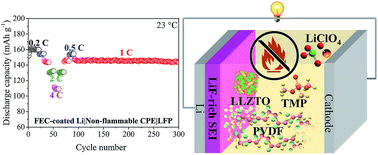Enabling non-flammable Li-metal batteries via electrolyte functionalization and interface engineering†
Abstract
Li-metal batteries (LMBs) with composite polymer electrolytes (CPEs) have attracted considerable attention compared with conventional Li-ion batteries. However, the uncontrolled Li deposition and the flammability of CPEs are still pressing issues. In this article, a non-flammable CPE is fabricated. The CPE consists of a poly(vinylidene fluoride) matrix, Li6.4La3Zr1.4Ta0.6O12 fillers, a flame-retardant trimethyl phosphate as the solvent, and a LiClO4 salt. It exhibits unique characteristics, including non-flammability, high ionic conductivity, flexibility, and good thermal stability. A fluoroethylene carbonate (FEC) additive is used on the surface of Li metal to facilitate the formation of a LiF-rich solid electrolyte interphase layer. The FEC-coated Li|CPE|LiFePO4 battery exhibits excellent cycling stability (at room temperature) with a discharge capacity of 152 mA h g−1 and nearly 100% coulombic efficiency over 500 cycles at 0.2C. The non-flammable CPE has a high rate capability of 109 mA h g−1 at 4C. To improve the energy density of the LMB, the LiFePO4 cathode is replaced with a high-voltage material LiNi1/3Mn1/3Co1/3O2. The obtained Li|CPE|LiNi1/3Mn1/3Co1/3O2 cell exhibits a discharge capacity of 109 mA h g−1 after 100 cycles at 0.2C. Consequently, the strategy offers guidelines for the future development of safe batteries with high energy density.



 Please wait while we load your content...
Please wait while we load your content...